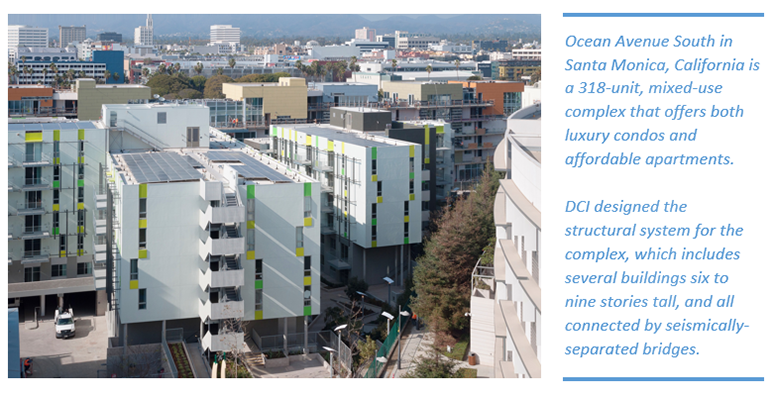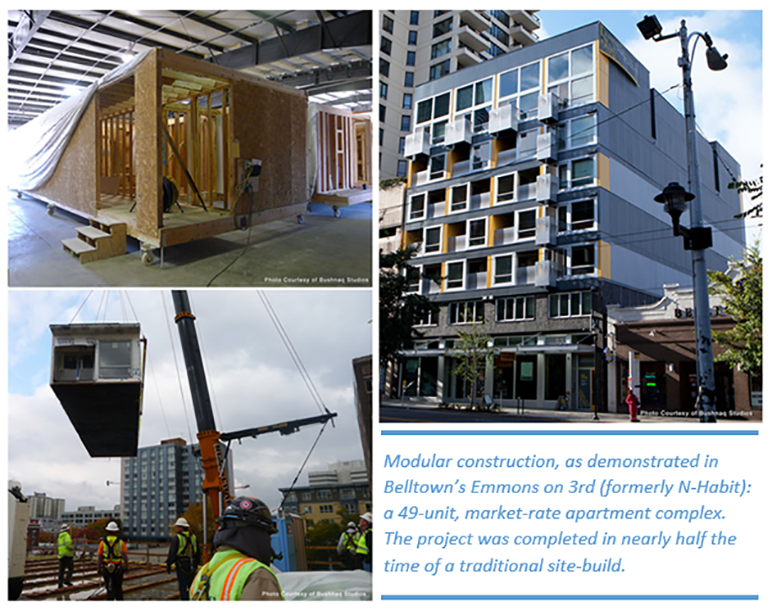There are cranes all over Seattle.
Not the avian variety, but the kind you see perched on construction sites throughout the skyline.
Seattle’s unofficial title of City with the Most Construction Cranes is reflective of it experiencing the highest level of development growth in its history. City officials anticipate that 115,000 new jobs and 70,000 housing units will be added over the next 20 years.
With that type of growth, the City of Seattle has adopted several measures to ensure all this new development doesn’t leave some folks behind.
One of the newest measures is the Mandatory Housing Affordability (MHA) program, which is an anti-displacement tool designed to create more market-rate and affordable housing through increases in development capacity. The MHA allows developers to increase residential and commercial capacity in exchange for providing market-rate or affordable housing. Otherwise, developers can opt to pay into a fund that will build these housing types elsewhere in the city.
Referred to as “The Grand Bargain,” the MHA triggers neighborhood rezones to accommodate for larger projects, with height increases proportional to a zone’s current maximum height.
And these requirements aren’t just for those taking advantage of the extra space, either. All new commercial and residential projects in these zones must contribute, regardless if they utilize the extra capacity, confirms Brennon Staley, a strategic advisor to the City of Seattle.
Nearby, other cities like Kirkland, Redmond and Issaquah have similar rezoning programs; as well as New York City. And throughout the country, cities are embracing affordable housing efforts through incentive programs.
DCI Engineers has provided structural and civil design work for several affordable housing projects throughout the country, ranging from low-income assisted living facilities to mixed-use apartments.

AFFORDABLE HOUSING – WHAT DOES IT LOOK LIKE?
The added floor area ratio (FAR) that is a result from the MHA program will most likely result in taller structures—literally--on Seattle’s horizon. This extra height may very well push these buildings to exceed other building code requirements, which needs to be addressed.
For example, the University District will go from a 240-foot maximum to 320-foot maximum. This automatically triggers Performance Based Design (PBD).
Funds generated from the MHA program will also generate more low- to mid-rise projects dedicated specifically to affordable housing. These are similar in scope to projects like Walton Place Two, a five-story, 40-unit mixed-use affordable housing project in Bellingham, Washington. The $13.5 million Whatcom County Housing Authority project was partially funded through Washington Works.
“I think [the MHA program] will create a broader range of housing options in urban centers and villages,” Brennon adds, noting buildings like cottages, rowhouses and small apartments. “Funds received by the Office of Housing go to a wide variety of housing types, but overall, they tend to fund 50-200 unit buildings.”
Aside from the physical makeup, affordable housing also carries special requirements, budgets and interests, as they are tied to local and federal funding.
Things like budget and schedule are closely tied together and it’s vital for all those on a project’s design team to not only work with these challenges, but to offer problem-solving solutions.
“Spending quality time at the front-end of a project and thinking through how it will be built reduces time spent during construction,” notes DCI Principal, Scott Erickson. “Usually the simplest structure is the most efficient.”
One such efficiency trend DCI is observing includes modular construction. Depending on the project scope, it can offer developers and housing authorities an accelerated delivery option. By timing manufacturing with site construction, pre-assembled units can arrive “just in time,” with the stacking process taking anywhere from four to six days, depending on project size, says DCI Principal, Troy Bean.

Funds generated from the MHA program aren’t just limited to new building projects, either.
“While it will primarily be used for new development, it may also be used for rehabilitation where it creates new affordable units,” Brennon says.
This means taking older, outdated structures and giving them new life – whether it’s seismic upgrades or basic tenant improvements.
For projects like 1st & Vine, an affordable housing apartment complex in Seattle, a retrofit means working with the existing structure and finding material solutions that translate to cost savings for the owner, not to mention the timing associated with working on a structure with tenants already in the building.
The work on 1st and Vine allowed at least half of the residents to stay during construction, but that’s not always the case.
Enter Temporary Relocation, a service that provides planning, coordination and budgetary assistance for projects that are moving tenants, particularly in affordable housing cases.
So, whether these residents are moving to a new location or need temporary housing during a renovation, developers and local housing authorities can serve their tenants with these relocation services, notes Mike McNeill, Senior Project Manager with DCI’s Right of Way department.
“There are certain requirements that you have to take care of with temporarily locating someone,” Mike says. “You have to transfer all of their utilities so their families still have a way of getting a hold of them, then you have to transfer them all back; You have to pack up all their stuff so they can move out so the construction company can go in and work.”
Mike notes major cities like San Francisco are taking on multi-year affordable housing projects, moving and relocating hundreds of individuals and families for necessary building renovations.

THE TAKEAWAY
Affordable housing comes in many shapes and sizes in cities throughout the country and with them, are the changing policies that evolve with an ever-growing landscape.
Staying adept at these changes will help A/E/C industry professionals anticipate the needs and challenges of such projects, ultimately helping shape communities and a city where everyone can call home.
Erin Spaulding, Associate, Communications Manager | Erin comes from a journalism background with an emphasis in feature writing. She enjoys capturing the unique details of a story and is a firm believer that every person (and every project, for that matter) has a story to tell. Erin loves running, fly fishing and learning about unique spaces. Back in Michigan, she owns a little studio condo that's been readapted from an asylum and turned into a mixed-use residential building.